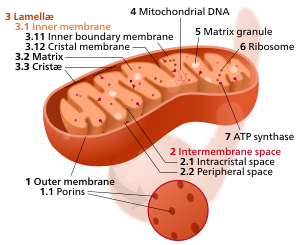| Cell biology | |
|---|---|
| mitochondrion | |
 Components of a typical mitochondrion
3 Lamella
4 Mitochondrial DNA |
In the mitochondrion, the matrix is the space within the inner membrane. The word "matrix" stems from the fact that this space is viscous, compared to the relatively aqueous cytoplasm. The mitochondrial matrix contains the mitochondrial DNA, ribosomes, soluble enzymes, small organic molecules, nucleotide cofactors, and inorganic ions.[1] The enzymes in the matrix facilitate reactions responsible for the production of ATP, such as the citric acid cycle, oxidative phosphorylation, oxidation of pyruvate, and the beta oxidation of fatty acids.[1]
The composition of the matrix based on its structures and contents produce an environment that allows the anabolic and catabolic pathways to proceed favorably. The electron transport chain and enzymes in the matrix play a large role in the citric acid cycle and oxidative phosphorylation. The citric acid cycle produces NADH and FADH2 through oxidation that will be reduced in oxidative phosphorylation to produce ATP.[2][3]
The cytosolic, intermembrane space, compartment has a higher aqueous:protein content of around 3.8 μL/mg protein relative to that occurring in mitochondrial matrix where such levels typically are near 0.8 μL/mg protein.[4] It is not known how mitochondria maintain osmotic balance across the inner mitochondrial membrane, although the membrane contains aquaporins that are believed to be conduits for regulated water transport. Mitochondrial matrix has a pH of about 7.8, which is higher than the pH of the intermembrane space of the mitochondria, which is around 7.0–7.4.[5] Mitochondrial DNA was discovered by Nash and Margit in 1963. One to many double stranded mainly circular DNA is present in mitochondrial matrix. Mitochondrial DNA is 1% of total DNA of a cell. It is rich in guanine and cytosine content, and in humans is maternally derived. Mitochondria of mammals have 55s ribosomes.
- ^ Voet, Donald; Voet, Judith; Pratt, Charlotte (2013). Fundamentals of Biochemistry Life at the Molecular Level. New York City: John Wiley & Sons, Inc. pp. 582–584. ISBN 978-1118129180.
- ^ Stryer, L; Berg, J; Tymoczko, JL (2002). Biochemistry. San Francisco: W.H. Freeman. pp. 509–527, 569–579, 614–616, 638–641, 732–735, 739–748, 770–773. ISBN 978-0-7167-4684-3.
- ^ Mitchell, Peter; Moyle, Jennifer (1967-01-14). "Chemiosmotic Hypothesis of Oxidative Phosphorylation". Nature. 213 (5072): 137–139. Bibcode:1967Natur.213..137M. doi:10.1038/213137a0. PMID 4291593. S2CID 4149605.
- ^ Soboll, S; Scholz, R; Freisl, M; Elbers, R; Heldt, H.W. (1976). Distribution of metabolites between mitochondria and cytosol of perfused liver. New york: Elsevier. pp. 29–40. ISBN 978-0-444-10925-5.
- ^ Porcelli, Anna Maria; Ghelli, Anna; Zanna, Claudia; Pinton, Paolo; Rizzuto, Rosario; Rugolo, Michela (2005-01-28). "pH difference across the outer mitochondrial membrane measured with a green fluorescent protein mutant". Biochemical and Biophysical Research Communications. 326 (4): 799–804. doi:10.1016/j.bbrc.2004.11.105. PMID 15607740.